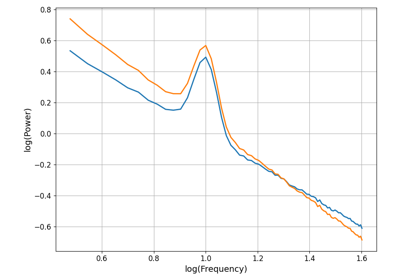fooof.sim.transform.rotate_spectrum¶
- fooof.sim.transform.rotate_spectrum(freqs, power_spectrum, delta_exponent, f_rotation)[source]¶
Rotate a power spectrum about a frequency point, changing the aperiodic exponent.
- Parameters:
- freqs1d array
Frequency axis of input power spectrum, in Hz.
- power_spectrum1d array
Power values of the spectrum.
- delta_exponentfloat
Change in aperiodic exponent to be applied, where:
positive is clockwise rotation (steepen)
negative is counterclockwise rotation (flatten)
- f_rotationfloat
Frequency value, in Hz, about which rotation is applied, at which power is unchanged.
- Returns:
- rotated_spectrum1d array
Rotated power spectrum.
- Raises:
- ValueError
If the rotation frequency is invalid.
Notes
Rotating in log-log spacing is equivalent to multiplying with a 1/f shaped mask that is:
unity at the rotation frequency
has an exponent of the desired delta exponent
This mask, when applied to a spectrum as ‘spectrum * mask’, should result in:
rotated_spectrum = 1/f^(original_exponent + delta_exponent), where
spectrum[rotation_frequency] == rotated spectrum[rotation_frequency]
This mask is defined as:
mask = (freqs / rotation_frequency) ** -delta_exponent
Note that this approach / function should only be applied to spectra without a knee:
If using simulated data, this is spectra created in ‘fixed’ mode.
This is because the rotation applied is inconsistent with the formulation of spectra with a knee. This transformation will change them in an unspecified way, not just limited to doing the rotation.
Examples
Rotate a simulated spectrum, changing the exponent around a rotation point of 25 Hz:
>>> from fooof.sim.gen import gen_power_spectrum >>> freqs, powers = gen_power_spectrum([1, 50], [1, 1], [10, 0.5, 1]) >>> rotated_powers = rotate_spectrum(freqs, powers, 0.5, 25)
